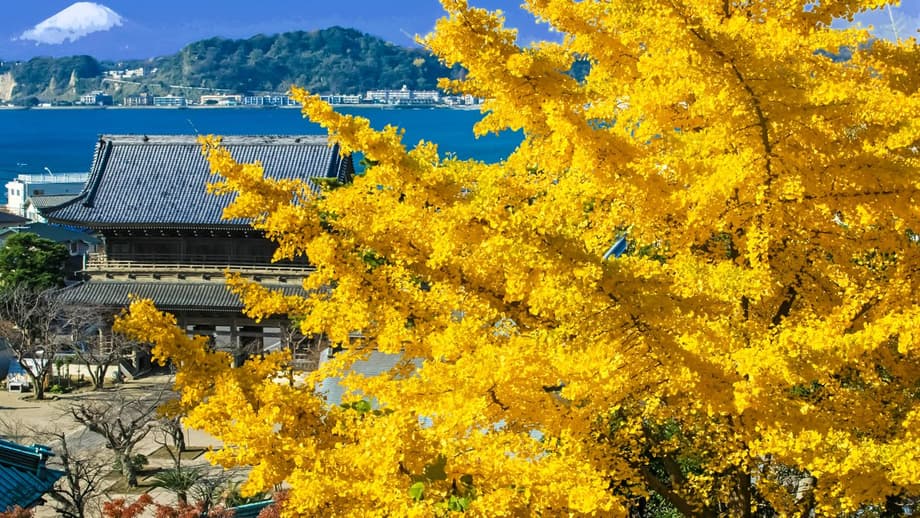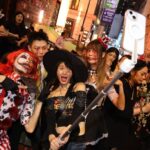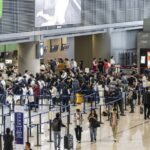Why Kamakura Shines in Autumn
Kamakura rewards slow travel, especially when the leaves turn. Hills cradle the old samurai capital on three sides and the Pacific opens on the fourth. That geography creates a rich mix of sea air, forested slopes, and temple precincts that glow each fall. Maples ignite in shades from tangerine to deep scarlet. Ginkgo trees turn a luminous yellow that drifts into golden carpets underfoot. Stone steps, copper temple roofs, and bamboo groves set the stage. Walking lets you take in the changing light, the rustle of leaves, and sudden views of valleys and pagodas.
- Why Kamakura Shines in Autumn
- When to Go and What to Expect
- A Classic Walking Route in North Kamakura
- Into the Eastern Hills, Kamakuragu to Zuisenji and Jomyoji
- Across Town to the Sea, Kotokuin and Hasedera
- Quiet Corners and Striking Contrasts
- Plan Your Day, Access, Hours and Costs
- Etiquette, Photography and Safety
- Food and Breaks along the Way
- Beyond the Temples, Hikes, Beaches and Views
- Highlights
Japan’s autumn leaf season is known as koyo. It is a nationwide pastime with its own rhythm and vocabulary, similar in spirit to spring cherry blossom viewing. Kamakura’s compact size, rail access from Tokyo, and density of temples make it one of the easiest places in the Kanto region to follow the color from gate to gate, then finish at the shore for sunset.
When to Go and What to Expect
Leaf color in Kamakura usually builds from mid November and peaks from late November into early December. The maples often hold their best reds and oranges into the first half of December, while many ginkgo trees crest a little earlier. In early December 2024, the maples were vivid across multiple temple grounds, while several ginkgo trees were nearing the end of peak. Warm, sunny days can prolong maple color, and colder nights can deepen tones. Rain highlights the shine on fallen leaves and stone, which makes temple gardens feel almost painted.
Expect comfortable daytime temperatures with cooler evenings. Bring layers, a compact umbrella, and shoes with good grip for wet steps and trails. Daylight is short, so start early. Most temple grounds close by late afternoon, with last entries around 4 pm to 4:30 pm. Evening events, such as special light ups at selected temples, are exceptions and have separate entry times.
A Classic Walking Route in North Kamakura
Start at Kita Kamakura Station, three minutes by train from Kamakura Station on the JR Yokosuka Line (JR stands for Japan Railways). The station opens onto a cluster of major Zen sites in a green valley. Paths and quiet lanes connect them. This route threads through Engakuji, Jochiji, Meigetsuin, and Kenchoji, each with a distinct feel and composition of trees, stone, and water.
Engakuji, a vast Zen precinct in peak color
Founded in 1282, Engakuji stretches up the hillside with ponds, corridors, and a procession of gates. The Sanmon gate frames the valley. Maples drape the stairways and the banks of Myokoike pond, where reds and golds ripple in the water. The temple’s Shariden, a reliquary hall, and the massive Ogane bell are national treasures. During peak color the lower slopes turn to a layered palette of green, yellow, and red, with pockets that reach full blaze at different times. Hours typically run from 8:30 am to 4 pm and entry for adults is around 500 yen, though schedules can vary by season and event.
Jochiji and the golden ginkgo carpet
A short walk leads to Jochiji, one of Kamakura’s five great Zen temples. In front of the main hall, the great ginkgo drops its leaves in a broad, glowing sweep. Staff often leave the fallen yellow leaves in place, which turns the forecourt into a luminous mat that changes with the wind and light. The surrounding slopes hold maples that warm to copper and crimson as the days shorten.
Meigetsuin and the circle window view
Cross the tracks to Meigetsuin, famed for hydrangeas in June. In autumn the temple invites a different kind of framing. The round window in the main hall looks into the inner garden, which opens only twice each year, in early summer and again in late fall (November to December). Maple leaves scatter around the approach and inner garden in reds and yellows that encircle the window’s soft geometry.
Kenchoji, grand avenues of Zen architecture
Continue south to Kenchoji, founded in 1253 and ranked first among the five great temples, known collectively as the gozan. The temple’s long axis runs through the imposing Sanmon gate toward the main hall. A side path to the left shelters clusters of maples that glow under afternoon sun. The scale here is commanding, with wide walks, tiered halls, and stands of trees that shift color at different altitudes. During late October to early December, Kenchoji often hosts an evening program called Zen Night Walk (dates vary by year). It pairs light, sound, and mist installations with the historic spaces. Sessions generally run from 5 pm to 8 pm with last entry around 7:30 pm, and tickets are sold in timed blocks, with early bird prices offered in advance.
These four sites make a natural circuit in about two to three hours at an easy pace, longer if you stop for tea or photos. From Kenchoji you can walk or bus toward the eastern hills, or head into central Kamakura for lunch before continuing.
Into the Eastern Hills, Kamakuragu to Zuisenji and Jomyoji
Board a short bus from Kamakura Station to Kamakuragu Shrine, a 19th century site set at the base of the hills. In autumn, lanterns softly light the approach at dusk and the maples near the shrine office turn a vivid crimson. Seasonal performances sometimes include takigi noh, a classical drama illuminated by firelight that lends the precincts a quiet glow.
Zuisenji rock garden and hillside color
From Kamakuragu, walk northeast along a gentle slope to Zuisenji, a refined Zen temple tucked into a forested bowl. The main hall sits among red and gold maples, and after rain the fallen leaves outline stones and moss in rich patterns. Behind the hall a rare rock garden is carved directly into a cliff face. Designed by the monk Muso Soseki, it is a nationally designated scenic site and an early masterwork of Zen garden design. The garden’s carved terraces and water channels gather fallen leaves that look like hand laid mosaics in late fall.
Jomyoji and a matcha break at Kisenan
Continue slightly south to Jomyoji, the fifth of Kamakura’s great temples. Only the main hall remains from its former, larger layout, and its broad copper roof provides a stately backdrop for a towering ginkgo whose leaves turn a lustrous yellow. Within the grounds, Kisenan teahouse serves matcha that you can sip while looking out onto a dry landscape garden. From here, Hokokuji is a short detour, with the city’s largest bamboo grove and an intimate tea spot inside. The crisp geometry of bamboo rises around maple leaves for a satisfying color contrast.
The eastern hills feel removed from the town despite their proximity. Stone paths, low gates, and forest edges make these stops quieter than the central corridor. Plan plenty of time to sit and watch the light move across leaves and rock.
Across Town to the Sea, Kotokuin and Hasedera
Shift west for the sea side of Kamakura. From Kamakura Station, ride the Enoden to Hase Station. Kotokuin, home to the Great Buddha of Kamakura, sits a pleasant walk from either Kamakura or Hase. The bronze statue, cast in 1252, rises about 11.3 meters and pairs well with seasonal color in the small gardens around it. Several maples near the statue reach full tone in late November to early December, and ginkgo trees add feathery yellow. Many visitors focus on the statue itself, so it pays to circle the grounds and look for maples set against low walls and wooden corridors.
Hasedera, temple of flowers and night lights
Hase’s hillside temple of flowers draws visitors year round. In autumn, stone steps climb through stands of maple toward the main hall. A large ginkgo beside the buildings turns a honeyed gold whose height rivals the roofline. The lower garden centers on a pond edged by maples and lanterns that reflect in calm water. Hasedera also runs an evening light up during the peak season (typically until early or mid December). In 2024, lights were scheduled through December 8, nightly from sunset until closing. The same grounds read differently after dark, with maples glowing and corridors traced by soft light.
Combine Kotokuin, Hasedera, and a quick stroll to Yuigahama Beach to cap the day. On clear afternoons the setting sun brushes clouds over Sagami Bay with pink and orange. The sound of waves offers a gentle coda after temple paths.
Quiet Corners and Striking Contrasts
Eishoji, just north of Kamakura Station on the western side of the tracks, has a rare distinction in the city. It is the only surviving temple led by female clergy. Seasonal plantings carry the calendar from plum blossoms through hydrangeas, then into red spider lilies in early autumn. In late fall, flashes of crimson and gold peek through the temple’s tidy bamboo grove, second in size only to Hokokuji. The combination of vertical green poles and drifting color delivers strong photos with little crowd pressure.
By the coast in the town’s southwest, Komyoji frames the season with a different kind of scene. Ginkgo trees near the temple can hang a curtain of yellow. On especially clear days Mount Fuji lines up beyond the leaves and rooftops for a classic snapshot of autumn in the Kanto region.
Plan Your Day, Access, Hours and Costs
Kamakura is an easy day trip from central Tokyo. The JR Yokosuka Line runs from Tokyo Station and Shinagawa Station to Kamakura Station in about one hour. For the north valley temples, ride to Kita Kamakura Station and start on foot. The Enoden connects Kamakura to Hase for the sea route. Local buses link Kamakura Station with Kamakuragu and the eastern hills. Trains run frequently and contactless IC cards are accepted.
- Typical hours: Many temple precincts open around 8:30 am and close by 4 pm to 4:30 pm. Seasonal evening programs have separate hours.
- Entry fees: Most sites charge 200 to 500 yen per adult. Engakuji, for example, lists 500 yen for adults and 200 yen for children. Some gardens inside temples have an extra fee.
- Crowds: Weekends draw many visitors from Tokyo. Arrive early, or visit on weekdays for more space and easier photos.
- Mobility: Expect uneven stone, dirt paths, and stairs. Wear shoes with traction. Rain can make slopes slick.
- Cash and facilities: Bring small bills and coins. Vending machines are common, but restrooms are spaced out once you leave the main streets.
- Evening events: Kenchoji’s Zen Night Walk typically runs from late October to early December with timed tickets. Hasedera’s autumn light up generally runs until early or mid December. Check official calendars for dates and entry rules before you go.
Etiquette, Photography and Safety
Temples are living religious sites. Keep voices low, step aside for worshippers, and observe any no photo signs inside halls. Tripods and drones are often restricted. Stay on paths and off moss. Do not pick leaves, even when they have fallen, since the carpets around ginkgo and maple trees are part of the seasonal display. If you bring children, set simple rules for running near ponds and stone steps. Early morning and late afternoon give the best color and shadows for photos, and overcast skies can make reds and yellows look rich and even.
Food and Breaks along the Way
Central Kamakura sits between the north valley temples and the sea. Komachi Dori, a pedestrian street near the station, is lined with snacks and cafes that make good refueling stops. Try shirasu, the local whitebait, served on rice bowls or in croquettes. Near the wooded east, soba at Matsubara an has a serene garden setting. Out by Shichirigahama, Awanouta serves a playful ramen made without artificial additives. For sweets, Kyo Kamakura on Komachi Dori turns out seasonal wagashi, including zunda flavors in November. Inside Jomyoji, Kisenan teahouse offers matcha with a garden view if you want calm and tradition without leaving the grounds.
Beyond the Temples, Hikes, Beaches and Views
Trails lace the hills around the city. The Tenen trail links ridgelines above Kenchoji and Jomyoji, with spots that open to the bay and, on clear days, Mount Fuji. In late autumn, forest sections blend evergreen and deciduous trees, so you walk through pools of color rather than a single blanket. Carry water and mind the roots and rocks. Near sunset, Inamuragasaki Park and Yuigahama Beach turn into easy viewing decks for pink skies and silhouettes of Enoshima. The mix of mountain light and ocean air is part of Kamakura’s draw.
If you plan around foliage, Kamakura usually peaks a touch later than some Tokyo hot spots. Many Tokyo parks and gardens crest in mid to late November. Kamakura often slides into peak in late November and early December. For travelers visiting in mid November who want a mountain hike at color peak, Mount Takao can be a strong alternative or addition. If your dates fall later, Kamakura’s maples often hold on nicely into early December, and some sites add evening lights that extend viewing hours.
Highlights
- Best color window runs from late November into early December, with maples often lasting into mid December.
- Start in Kita Kamakura for Engakuji, Jochiji, and Meigetsuin, then continue to Kenchoji for grand Zen architecture and maple clusters.
- Ride a short bus to Kamakuragu and walk to Zuisenji’s cliff carved rock garden and Jomyoji’s teahouse. Hokokuji’s bamboo grove is nearby.
- Head west to Kotokuin for the Great Buddha and to Hasedera for pond gardens, a giant ginkgo, and an autumn evening light up (in 2024 through December 8).
- Eishoji offers a quieter visit with foliage glimpsed through bamboo, while Komyoji by the coast can frame ginkgo gold with Mount Fuji on clear days.
- Kenchoji’s Zen Night Walk runs evenings from late October to early December, with timed tickets and immersive art installations.
- Typical temple hours are 8:30 am to 4 pm to 4:30 pm. Entry fees commonly range from 200 to 500 yen. Check official sites for updates.
- Access from Tokyo is simple via the JR Yokosuka Line in about one hour. The Enoden links Kamakura Station and Hase for the sea route.
- Wear good shoes for stone steps and forest paths, bring layers, and keep voices low around worship spaces.




